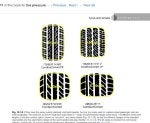The MYTH Of Wider Tire Contact Patch Being of Greater Size: Dispelled!
So I took it upon myself to magnify and measure the tire contact patch areas in square inches, as illustrated on page 291 of 'Automotive Engineering' edited by David A. Crolla, copyright 2009 Elsevier Publishing.
Now: the popular (mis)conception is that that a wider wheel/tire will produce a larger contact patch than that of a narrower wheel/tire combination, given the same make and model of tire applied to the same vehicle.
Well, what is really happening is that the orientation of that patch changes, from longitudinal to lateral(side to side) not the area. Exactly what you don't want, unless you plan to drive the car sideways at least fifty percent of the time! I believe the term for that is 'drifting'.
Anywho, the results of my measurements are (hopefully) attached: In case you have difficulty reading the area(sq. in):
Upper set of tires (L) 8.51 sq. in (R) 8.46 sq. in
Lower set of tires (L) 9.1 sq. in (R) 8.34 sq. in
![Image]()
![]()
Again, my measurement tool in PowerPoint is approximate, but the point has been made: given two sizes of the same tire model on the same vehicle, with appropriate cold air pressures applied, only the orientation of the contact patch changes, and actually the patch from the wider tire is slightly smaller.
When it comes to my preference for narrower, smaller diameter wheels wrapped in narrower, higher profile rubber... I REST MY CASE: The contact patches of the tires on a motor vehicle should be oriented longitudinally, parallel to the direction said vehicle is intended to travel in.
This will enhance - or at least preserve and maintain - sufficient self-aligning torque - or return from turns, as well as resist tramlining(following ruts and other road imperfections) and make driving a more relaxing and pleasant experience.
So I took it upon myself to magnify and measure the tire contact patch areas in square inches, as illustrated on page 291 of 'Automotive Engineering' edited by David A. Crolla, copyright 2009 Elsevier Publishing.
Now: the popular (mis)conception is that that a wider wheel/tire will produce a larger contact patch than that of a narrower wheel/tire combination, given the same make and model of tire applied to the same vehicle.
Well, what is really happening is that the orientation of that patch changes, from longitudinal to lateral(side to side) not the area. Exactly what you don't want, unless you plan to drive the car sideways at least fifty percent of the time! I believe the term for that is 'drifting'.
Anywho, the results of my measurements are (hopefully) attached: In case you have difficulty reading the area(sq. in):
Upper set of tires (L) 8.51 sq. in (R) 8.46 sq. in
Lower set of tires (L) 9.1 sq. in (R) 8.34 sq. in

Again, my measurement tool in PowerPoint is approximate, but the point has been made: given two sizes of the same tire model on the same vehicle, with appropriate cold air pressures applied, only the orientation of the contact patch changes, and actually the patch from the wider tire is slightly smaller.
When it comes to my preference for narrower, smaller diameter wheels wrapped in narrower, higher profile rubber... I REST MY CASE: The contact patches of the tires on a motor vehicle should be oriented longitudinally, parallel to the direction said vehicle is intended to travel in.
This will enhance - or at least preserve and maintain - sufficient self-aligning torque - or return from turns, as well as resist tramlining(following ruts and other road imperfections) and make driving a more relaxing and pleasant experience.




